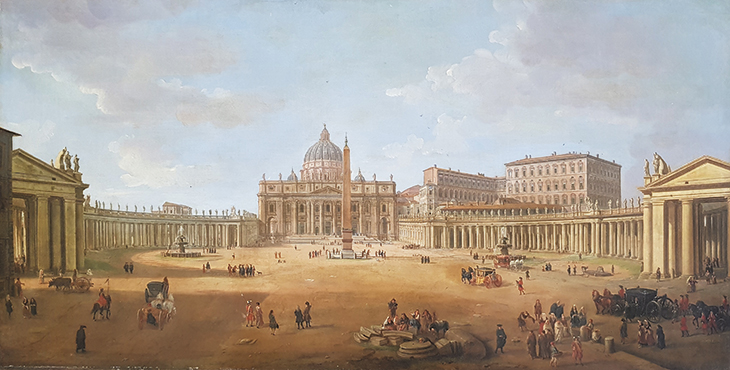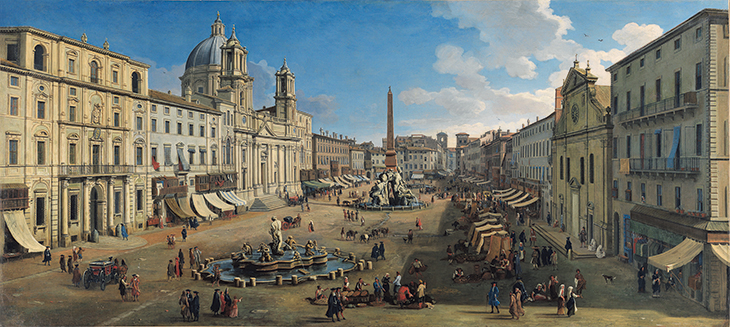The task of honouring a native son who left home at an early age to seek and find success abroad, seldom if ever to return, is a delicate one. At Kunsthal KAdE in Amersfoort, a 45-minute drive south-east of Amsterdam, it has been accomplished with energy and grace. Caspar Adriaensz. van Wittel (1653–1736), alias Vanvitelli, alias Gasparo degli Occhiali, alias De Toorts (‘The Torch’), exported a new pictorial genre, the urban landscape, from a new country, the United Provinces – its existence formally recognised a scant five years or so before his birth, its boundaries vigorously contested during his youth – to one at once inestimably old and yet to come into being, namely Italy.
Van Wittel practised his trade with some distinction in Rome, Naples, Venice and Florence, among other places, winning admission to the Accademia di San Luca in Rome and mixing on cordial terms with various princes and viceroys, not to mention visiting milordi. He more or less singlehandedly devised what is known in his adopted language as the veduta: without him no Carlevarijs, Guardi, Bellotto or Canaletto; nor, arguably, any Panini or Piranesi. Yet he remained a prophet without honour in his homeland, possibly because Dutch patrons were less susceptible to the allure of Italy than French or British ones.
The exhibition at Kunsthal KAdE – handsomely installed in a high-ceilinged, semi-subterranean rectangular space, with smaller galleries running along one side at ground-floor level – follows Van Wittel from a fairly impoverished childhood in Amersfoort to a fruitful apprenticeship with Matthias Withoos, an associate of the architect Jacob van Campen; to Hoorn, where Withoos fled to escape the predations of the French and British during the rampjaar (‘Disaster Year) of 1672; and, not long after that, to Italy. In Rome Van Wittel fell in with the Bentvueghels (‘birds of a feather’), the Dutch artists’ colony. He also befriended, and may have worked with, Cornelis Meijer, a civil engineer who on behalf of the pope was seeking ways to make a stretch of the Tiber navigable. His earliest surviving datable work is a view of Piazza del Popolo marked ‘1680’.
Piazza San Pietro (1715), Caspar van Wittel. The Earl of Leicester and the trustees of Holkham Estate, Holkham Hall, Norfolk

It’s probably through Meijer rather than the ‘birds of a feather’, whose sodality was notoriously boozy and rowdy, that Van Wittel reached the attention of the Colonnas and other aristocratic patrons; these included the future viceroy of Naples, Luis de la Cerda, Duke of Medinaceli, who officiated as godfather to Van Wittel’s son Luigi (later to be the architect of the palace of Caserta in Naples). In the second decade of the new century William Kent, still a painter rather than an architect, introduced Lord Burlington and Thomas Coke, Earl of Leicester, two exemplary Grand Tourists, to Van Wittel’s work. It could be argued, then, that he didn’t just influence Canaletto – which he clearly did, though there’s no one picture by Van Wittel that we know Canaletto must have seen – but that he also created an English taste for the sort of paintings which Canaletto would go on to produce.
The canon of work left behind by Van Wittel contains plenty of doublings and repetitions. He often reused the same preparatory drawing several times, and he’d return to popular views at intervals, presumably as and when commissions arose. As a result, the exhibition has a kind of rhythm to it: small differences in light and tonality, and variations in the lively foreground details of merry monks, sketching artists and assorted passers-by catch the viewer’s interest. The curators have helpfully displayed a large reproduction of Giambattista Nolli’s Pianta Grande di Roma (1748), with little circles indicating the viewpoints favoured by Van Wittel.
Naples, Riviera di Chiaia (1710–22), Caspar van Wittel. Courtesy Lampronti Gallery

They also speculate about how the painter attained his characteristic elevated viewpoints, and whether he used a camera obscura or other mechanical devices to achieve his mastery of perspective. Some sort of scaffold and yes he did, are their conclusions. Van Wittel’s use of optical aids is most clearly witnessed by distortions in the margins of pictures – cylindrical drums on churches that appear elliptical, and so on – though of course these details tend to disappear when one stands in front of the larger paintings.
As able and enjoyable as the paintings and drawings are, they can appear quite impersonal. There’s none of the febrile intellectual engagement with antiquity later seen in Piranesi prints, and none of the sheer mastery of oil paint of the Venetian settecento: the flickering curlicues that dance across a Canaletto like white horses at sea; the swift zigzags that give a Guardi its proto-Romantic intensity. Van Wittel’s handling of paint is more workmanlike, though in his large oils he is good at letting the underpaint come through to lend a unified tone, and his smaller works in gouache and, occasionally, tempera have a pleasing opalescent quality. As one might expect, the curators are at pains to stress the idea that Van Wittel brought a Dutch sensibility to bear on his Italian subjects, and there may be something in that – though in several paintings, particularly those depicting views in and around Naples, the palette is strong and sun-baked, as redolent of the warm South as any oltremontano could wish.
Piazza Navona (1699), Caspar van Wittel. Carmen Thyssen-Bornemisza Collection, on loan to the Museo Nacional Thyssen-Bornemisza, Madrid

So what was Van Wittel for? What need did he serve or create? Tellingly, he was as interested in the modern buildings of Rome or Naples, the churches and palaces, as he was in their abiding antiquities (painting the odd view of the Colosseum or the Grotta di Seiano, for example). For his Italian patrons, more significant to his career than British or French ones, Italy was an ancient place in need of renewal: a renewal that they themselves might well be supervising or funding.
It is this, as much as his slightly prosaic lucidity, his compositional conventions or northern light, that connects Van Wittel’s Italian views with the new urban landscape of the north. The Netherlands was a country still coming into being, and every dyke and city wall in every 17th-century Dutch painting testifies to that. Likewise, Italy was, or so its more enlightened princes hoped, a land with a present as well as a past – some sort of future, even. You could say Van Wittel grasped that rather more acutely than his better-known successors.
‘Maestro van Wittel: Dutch Master of the Italian Cityscape’ is at the Kunsthal KAdE, Amersfoort until 5 May.
From the March 2019 issue of Apollo. Preview the current issue and subscribe here.



